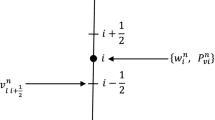Abstract
Of the many physical and chemical factors influencing the migration of salt in the ground, only molecular-filtration diffusion, convective transport, and salt exchange between the porous soil skeleton and the moving solution are usually taken into account [1]. The salt-exchange process is of a diffusion nature (“internal” diffusion) and depends on the types of soil and the nature of their salinization. We may assume that soils of a heavy mechanical composition (clay, heavy loam) possessing high moisture-retention capacity are most appropriately modelled by a heterogeneous porous medium with porosity m = m1 + m2, where m1 denotes the volume of transit pores occupied by the moving solution and m2, the volume of terminal pores, filled with a stationary solution (“bound” moisture). In this case, the internal diffusion mass-exchange process between both types of pores is described [2, 3] in the form of Freundlich-type isotherms,
where c (x, t) and N (x, t) are the concentrations of solutions in the transit and terminal pores, respectively, t is the time, x is a coordinate, and α is the kinetic parameter. Salinization of soil of light mechanical composition (sand, light loam) with low moisture-retention capacity is associated with the presence of salts in the solid phase. We must write kinetic equations for salt dissolution in place of Eq. (0.1). Some types of these equations have been previously presented [1–5]. In this work, three problems modelling the soil desalinization process and admitting analytic solutions for arbitrarily given initial salinization are considered. It is assumed here that the “internal” diffusion process occurs sufficiently rapidly (or infinitely rapidly) in comparison with the “external” diffusion process and convection.
Similar content being viewed by others
Literature cited
The Course of Studies on Filtration Theory in the USSR (1917–1967) [in Russian], Nauka, Moscow (1969).
H. A. Deans, “A mathematical model for dispersion in the direction of flow in porous media,” Trans. AIME,228, 49 (1963).
L. B. Dvorkin, “Theory of convective salt diffusion in porous media. III. Convective salt diffusion in porous media, taking into account the influence of “terminal” pores,” Zh. Fiz. Khim.,42, No. 4, 948–956 (1968).
N. N. Verigin, “Dissolution and erosion of salts in soils,” Nauchn. Dokl. Vys. Shkoly. Stroitel', No. 2 (1965).
V. I. Pen'kovskii, “Linear salt dissolution and erosion problem with filtration with high Péclet number,” Zh. Prikl. Mekh. Tekh. Fiz., No. 2 (1969).
R. Courant and D. Hilbert, Methods of Mathematical Physics, Vol. 2, Wiley.
V. V. Rachinskii, Introduction to General Sorption and Chromatography Dynamics Theory [in Russian], Nauka, Moscow (1964).
H. C. Carslaw and J. C. Jaeger, Conduction of Heat in Solids, Oxford University Press (1959).
M. A. Lavrent'ev and B. V. Shabat, Methods in the Theory of Functions of a Complex Variable [in Russian], Gostekhizdat, Moscow (1958).
Yu. I. Kapranov, “Some exact solutions in soil desalinization problems,” Izd. Akad. Nauk SSSR, Mekh. Zhidk. Gaza, No. 1 (1972).
Additional information
Translated from Zhurnal Prikladnoi Mekhaniki i Tekhnicheskoi Fiziki, No. 5, pp. 186–191, September–October, 1975.
Rights and permissions
About this article
Cite this article
Pen'kovskii, V.I. Mathematical modelling of the soil desalinization process. J Appl Mech Tech Phys 16, 833–838 (1975). https://doi.org/10.1007/BF00854100
Received:
Issue Date:
DOI: https://doi.org/10.1007/BF00854100




